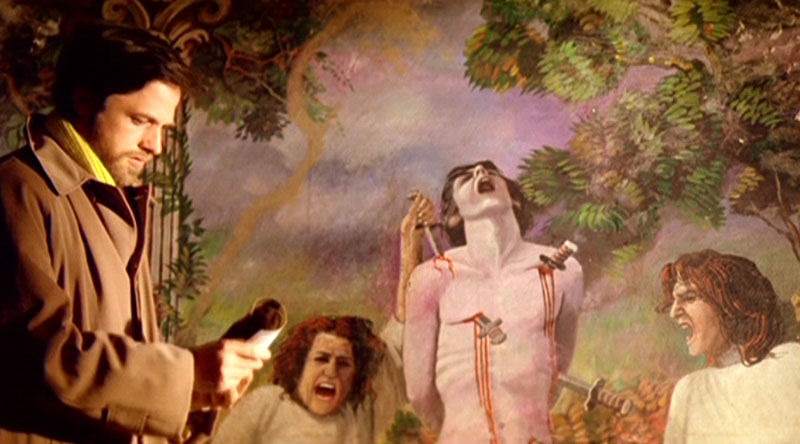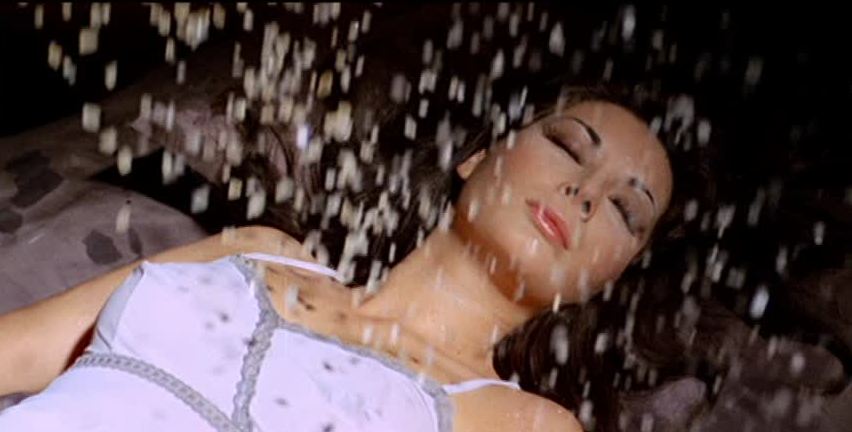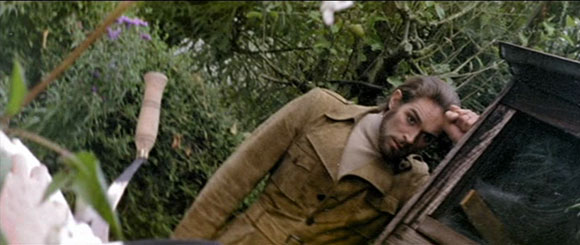6. Deep Red (1975, Dario Argento)

There is someone at the door. The psychic goes over to answer it. The killer’s already inside, right? Or they do a tug of war at the door? Or they do the ol’ switcheroo; a friend is at the door maybe? No. Dario uses our knowledge against us. Argento’s psychic reaches for the knob, senses the killer on the other side of the door, gasps and pulls back, only for the killer to bust the door down anyways, immediately followed by a hatchet thudding into her face.
Beautiful. The set-pieces in Argento’s movies are the death scenes wherein the arid constraints of the common horror motifs somehow provide him fertile soil for innovation. Deep Red combines the creepy artificial feeling of Night of The Hunter’s sets with those of the dreamlike La Belle et La Bette to provide a snow globe of nightmares in which the thriller unfolds.
By so investing in this artificial universe (the wet noir night streets, a café that is literally a recreation of Edward Hopper’s Nighthawks, the famous lights with no source), Argento’s best gialli don’t feel like they belong in the rest of the family. There are seldom on-location shots, almost no use of a Steadicam, only a loose affiliation with continuity editing. Would a doll really burst through a closet door, or is that shot just an excuse to scare the hell out of you? Because it works.
7. Torso (1973, Sergio Martino)

If a horror movie insists on rehashing the heroine in the woods, the naked women in a cabin, the pot smoking, the killer popping up from what must have been plain sight to the victim, why not have fun with it, like Torso does? Torso is about breasts, and about pot, and about falling down at inopportune times. The lady smokes too much pot, and when she walks through the forest in the mud with her shirt undone, he loses her balance and gets stuck in the mud. Thus, the killer can still stalk at a slow walk, because it now makes sense that he would.
Sergio Martino settles the question of following logic and motivations through to the core. You shouldn’t refrain from pot because someone will then kill you. You should refrain because it will slow your reflexes if someone tries to. You shouldn’t refrain from sexual promiscuity because the universe will hate you. You should refrain because you’re flaunting it in front of a sexually repressed psychopath. And so on.
Every horror movie you’ve yelled at raised the question, “how good of a movie would it have been if she just got up and kept running?” Torso gives the answer. They could have been excellent.
8. The House of the Laughing Windows (1976, Pupi Avati)

There is no delicate way to say this, but the point does need to be made to show how undervalued gialli are. If you Google The House of the Laughing Windows, and also The Strange Vice of Mrs. Wardh, for that matter, the only video you will find of the whole movie is hosted on a porn site. This is how appreciated one of the great Italian thrillers is. And, no, it’s not even close to pornography. It’s a look at the setpiece-as-character, when said character is dead.
Everything is brown, the village is overrun by vines. The main character sleeps in a house he can only get to through a near jungle of weeds and overgrown bushes. Everything is dead, and every character dresses accordingly. The suits are brown, the once-bright shirts have faded with sweat and age. Nothing is really alive, even the people. The protagonist, upon his first visit to his new quarters, finds an old sick woman laying in her bed. The house itself is unfurnished and eaten away; it’s essentially abandoned, and yet an human being who needs tending is trapped in it.
This mixes perfectly with his job. He ostensibly is hired to fix a faded church fresco, and then giallo stuff happens. The village is, in a sense haunted. The church certainly is, and the opening credits of a man strung up and tortured suggests the Indian Burial Ground trope. But what a deviation from the curse that lives! The only things alive enough to do evil now are the inhabitants of this little town, save for a “friend” and the love interest.
Though normally, the love interest always seems forced in gialli (an excuse to show nipples, really), it’s really one of two genuine connections in the entire movie, the other being with the old lady. The fact that this romance is handled no differently than in any other giallo is a testament to how dead Avati was able to make the village seem, and to how legitimate the logic thus is. If you were hired to state at a wall all day in a town comprised of people who hate you and dust, would it really take too much convincing to fall in love with a nice, pretty lady?
This may not even have been a major concern for Avati, but it sets up the dominoes so well! When she dies a great death scene, we actually care about her (as opposed to A Bay of Blood, where we care about the weapon). You can toy with whatever you want, so long as you obey the rules you establish. Avati established three wholly new thoughts on his craft in this one movie. Most directors strive to come up with one per lifetime.
9. The Strange Vice of Mrs. Wardh (1971, Sergio Martino)

In a welcome twist, The Strange Vice of Mrs. Wardh shows naked women in only nonsexual situations. Frequently. Getting ready for a bath, changing shirts, getting in a fight (oddly enough, Sergio Martino seems to be the only guy around bold enough to admit that there is nothing inherently sexy about women punching each other in the face, plus breasts).
This helps reinforce the point at the end, that none of this had anything to do with romance. None of it had anything to do with anything, really. Mrs. Wardh’s strange vice was not so strange after all; she loved herself more than anything, even the promise of fidelity to her husband. Not that he really cared either. Or her lover. Or the guy they both hired to kill her. So, what was it all about?
It’s about one moment that exemplifies every height giallo ever reached. So the contracted killer is out to get Wardh, and he gets her in the kitchen. He smothers her unconscious, cuts the gas wire, shuts the window and grabs the ice tray. Wait, what? The scene slows down to a halt, and sees the hitman grab a single ice cube. He lifts the falling-lever door lock and balances it perfectly, so that it’s about to fall down.
He then takes the ice cube, melting in his hand, and molds it to the lever, so that when he shuts the door behind him, the disappearing ice weighs the lever down perfectly into the latch, creating a door locked from the inside for the police. Martino could have just given the villain a key. But is that why you pop in a mystery?
10. What Have You Done To Solange? (1972, Massimo Dallamano)

This is a rough one. They forced an abortion on Solange, so her father mimicked the procedure on her friends, with an actual weapon. The audience doesn’t even know she exists for the first two thirds of the movie, though. She suffered mental trauma after the procedure, so her father kept her locked up in the house. If any of this sounds thrilling to you, then please stay away from me and my family. This is a drama made in the style of giallo.
There are no impressionist color schemes, no ramped up music to induce a good time. A teacher, who admittedly was sleeping with his eighteen year-old student, is suspected of the murders taking place in the girls’ school. His career is falling apart, his marriage is falling apart. The police chief on the case suffers from an incompetent staff that allows the killer to walk right by them, saluting the chief on an undercover mission. Everyone is trying to keep it together.
This set-up is shattered by the punchline; why were you not concerned about the victims all along? Why were you interested in an adulterer’s happy ending? Young women are being murdered by, well, unspeakable means.
The common area of exploration for gialli are overused motifs, not usually the narrative structure itself (another big notable exception being Investigation of a Citizen Above Suspicion). Dallamano handles this unexpected gift with an ironic ease, considering the uncomfortable subject matter.
While it is certainly a giallo, it feels more like a slasher, combined with a film noir. For a completely new take on familiar territory, What Have You Done to Solange is your movie, one of the dark peaks of Italian thrillers.
Author Bio: Patrick works full time in childcare. He spends his free time pursuing adult hobbies, such as writing about his favorite movies.